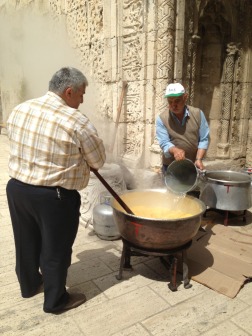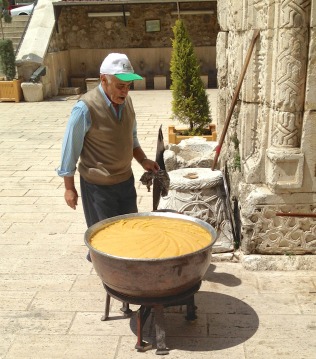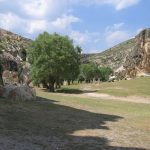 In front of the entrance to Eğirdir’s magnificent Dundar Bey Medrese Tahir Usta is stirring a vast cauldron of a curious yellow paste. I peer into it suspiciously. There are patches of oil on the top and pistachios floating haphazardly round the edges.
In front of the entrance to Eğirdir’s magnificent Dundar Bey Medrese Tahir Usta is stirring a vast cauldron of a curious yellow paste. I peer into it suspiciously. There are patches of oil on the top and pistachios floating haphazardly round the edges.
“What is it?” I ask.
“Irmak helva,” comes the reply.
For most Westerners helva is a solid block of a sesame-seed treat that crumbles at the touch of a carving knife. In Turkey, though, helva is a generic name for all sorts of sweet treats. This particular version is being prepared for a mevlut, Tahir explains, a mevlut being a prayer ceremony to remember the dead after which family members often distribute helva to friends and acquaintances.
With 500 to cater for, Tahir has been up and cooking since 8.30 this morning. First he had to prepare the butter by boiling it up in a smaller cauldron, all eighteen kilos of it. That done he skimmed off the oily part and mixed it with ırmak (semolina), sugar and water, before dropping in the pistachios. Now he has been stirring the resulting mix for two and a half hours while a şerbet (sherbet) mix of sugar and water bubbles away in another cauldron behind him.
 Two other men are helping with the stirring which, when I try it, turns out to be a heavy business, rather like turning wet laundry. But Tahir is not called an usta (master) for nothing. In day-to-day life he whips up wedding banquets, which means that he’s well used to the heavy cooking. I laugh silently as I watch his much heftier colleague give up and hand the thin wooden paddle used for the stirring back to Tahir, a slight and wiry man in late middle age, who immediately commences stirring in a lackadaisical manner that yet causes waves of helva to ripple round the cauldron.
Two other men are helping with the stirring which, when I try it, turns out to be a heavy business, rather like turning wet laundry. But Tahir is not called an usta (master) for nothing. In day-to-day life he whips up wedding banquets, which means that he’s well used to the heavy cooking. I laugh silently as I watch his much heftier colleague give up and hand the thin wooden paddle used for the stirring back to Tahir, a slight and wiry man in late middle age, who immediately commences stirring in a lackadaisical manner that yet causes waves of helva to ripple round the cauldron.
Slowly but surely the oil is being absorbed into the mixture but still I would hardly have called it set and it’s hard to imagine how it’s to be served to mourners as soon as lunchtime prayers are over. Then Tahir carefully lifts the lid on the second cauldron, scoops out the boiling liquid in a bucket and pours it into the helva. Again and again he pours, and to my great admiration it turns out that he has boiled precisely the amount required to fill the first cauldron to the brim. Then again he starts vigorous stirring and almost immediately the helva starts to stiffen so that soon he’s lifting it and turning it, lifting it and turning it, as thick ridges start to form.
Helva-making, it turns out, is a matey kind of business. It’s not just me who’s keen to take a look in the pot. The Dundar Bey Medrese is set in a strange sort of Selçuk walkway in the middle of old Eğirdir. People come down the steps on one side of a sunken courtyard, then mount the steps on the opposite side that pass under the minaret of the Hızırbey Cami. Each and every one of them pauses to smile, wave and call out words of encouragement, while the shoppers and tourists streaming through the medrese – now turned into a mini-mall – also pause to peer into the cauldron and admire its steaming contents.
At last Tahir Usta is satisfied with his work. He smooths over the top of the mix with the paddle as if it were a cake, then turns it on its side and uses the edge to decorate the top with curves that resemble the shutter pattern on an iPhone camera. Then to my great delight he spoons out a taster of the warm mix for me to try. It’s sweet but not too sweet, fudgey but not too thick.
The only disappointment is that I’m served my helva on a plastic spoon. In the past, I think ruefully, the cauldron would have been a solid thing of metal made to last down the decades. Now it’s an aluminium version that doesn’t look as if it will have much staying power.
But that’s to nitpick needlessly. As I swallow my helva I gaze up at the riotous stone patterns that twist themselves around the gateway to the medrese. Originally it was designed for the Keyhüsrev Kervansarayı on the outskirts of modern Eğiridir but when that burnt down in 1301, Dundar Bey, the Hamitoğulları ruler, had it moved here to adorn his new medrese instead. 
Did they celebrate its opening, I wonder, with a cauldron of helva shared out amongst the workmen? If so, I’ve just been partaking in a tradition that has endured for almost 800 years.
Written: 14 May 2013

